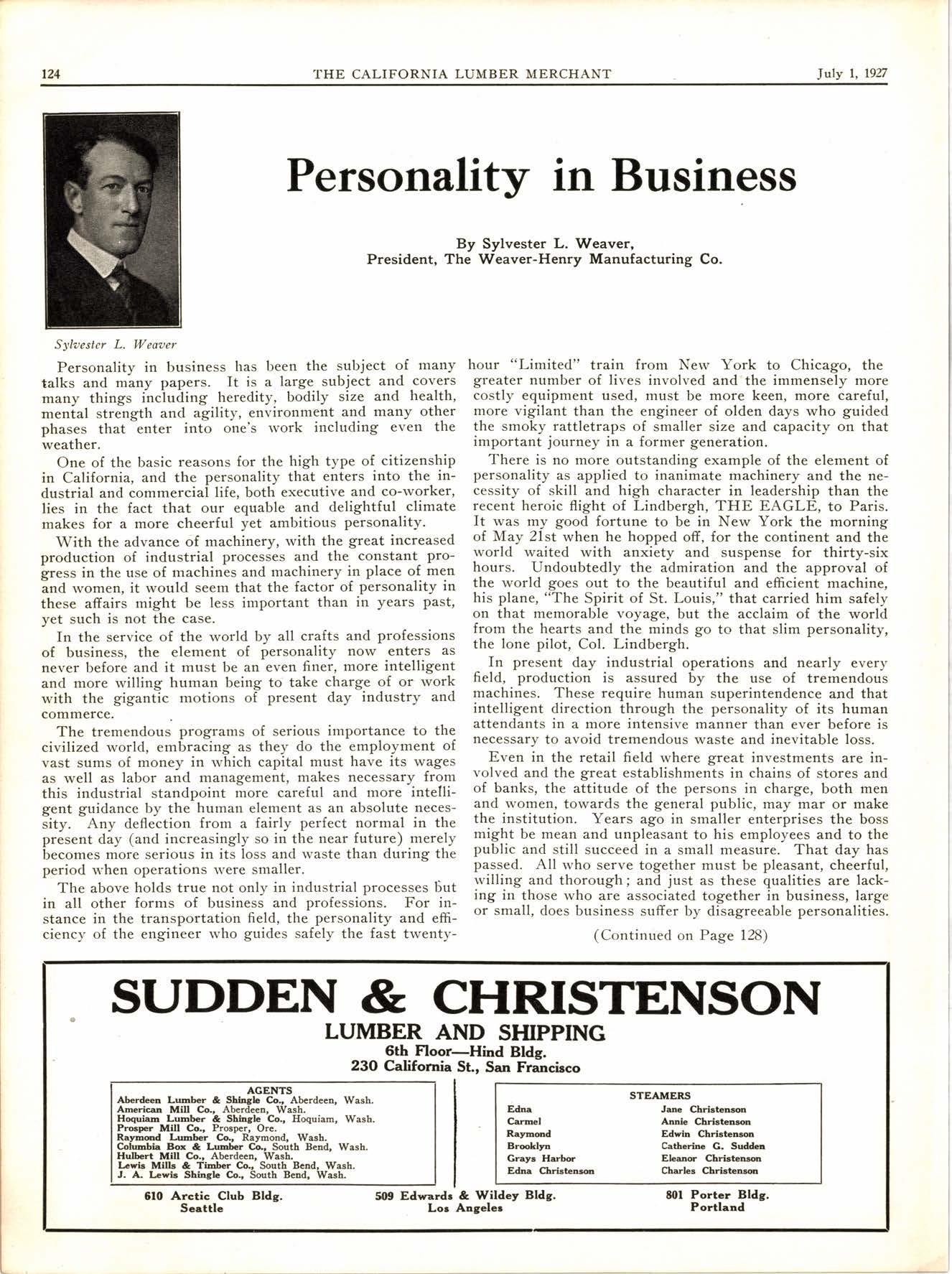
3 minute read
The California Pine Situation
By C. Stowell Smith, Galifornia White and Sugar Secretary-Manager, Pine Manufacturers' Assn.
The horizon is rapidly clearing for the pine industry. The barometer is rising and from all directions come indications that a sound stabilized market is not far distant.
The industry entered 1927 with large stocks and prospects of large production. The first few months developed a pessimistic attitude which might have resulted disastrously had not the leaders taken time to analyze the situation and apply correctives.
On January l, 1927, there was on hand in the pine region of California and Southern Oregon nearly one billion feet of lumber, of which over three-quarters was uncovered by orders-an advance of approximately 175 million over January L, 1926. On May I, 1927, the total stocks had been reduced over one-quarter and the amount for sale nearly 4O per cent, so that on the first of May, 1927, there was actually several million feet less lumber available than on the same date in 1926.
How was this gratifying result accomplished? Simply by each individual manufacturer sitting down and studying the situation as applying to his owfi operations and applying the obvious remedy, curtailment of production. Some mills cut off the night shift. Others went on a fiveday week and still others delayed starting up after the winter shut-down. A few steamed right ahead in spite of the perfectly apparent warnings of over-supply and weak market. Fortunately, the total volume produced by these unique economists was so small that it did not materially affect the situation. The net result is shown by the sfatistical position in rvhich twenty-two of the leading pine oper- ators found themselves on Mav 28. 1927-the latest date upon which authentic informaiion is available. On that date, these mills had produced 41 per cent less lumber than in 1926, had shipped 49 per cent more than produced, and had accepted orders 48 per cent greater than their production since the 1927 operating season started. Boiled down, the answer is that there is not so much lumber available in the pine region as there was a year ago.
What does this mean in actual dollars and cents since, in the last analysis the lumber industry, like all others, must translate its business'into profits or losses?
At the beginning of. 1927, the pine industry was faced with a falling market and if it had not reduced its production a further decline would have been inevitable.
By reducing its stocks tfie industry not only stopped the slide but actually created a demand which resulted in prices generally higher on June lst than on January 1,1927.
The largest increase was in Factory grades, varying from $1.50 to $3,00 per M although Selects also showed some gain. No. 3 and 4 Common boards responded from $1.00 to $1.50 and No. l and 2 Dimension from $.50 to $1.00. Box advanced nearly $2.00. B&Btr. and C. bevel siding and No. 1 and 2 Lath increased slightly. Cedar pencil stock, owing to increased pencil factory capacity, went up over $5.00. A few grades have just about held their own. None have slumped appreciably.
All in all the pine lumber manufacturers in California and Southern Oregon have met a difficult situuation wisely and have laid the foundation for a satisfactory operating year.
Wooden vs Metal Airplanes
Interviewed in Berlin, Clarence Chamberlin, the second aviator to cros! the Atlantic from mainland to mainland, expressed doubt, according to a NEW YORK TIMES cablegram, as to whether all-metal planes, such as are prevalent in Germany, were superior to machines with wooden planes for the wings.
"'We can re-cover our wings rvith cloth from time to which makes them practically new, while once the metal is worn out you must build a new plane,' he said to the German correspondents.
"'But isn't there greater danger of fire with wooden planes?'one asked.
"'Chamberlin smiled and
"'When gas blows up it's hot, no matter whether you are on metal or wood."'
It reflects great credit on the material with which men have almost universally framed-if not enclosed and covered-their houses, that not only Chamberlin's, but also Lindbergh's plane are of wooden construction-and are the most powerful planes with respect to relative weight-lifting capacity that the world has yet produced.
Aeronautical engineers say that even in the United States a drift in the last three or four years toward all-metal has been evident. Whether this is a sound tendency, or merely a fad will be revealed as a result of the serious attention the advantages of wooden construction will receive in consequence of its triumph in the "Spirit of St. Louis" and the "Columbia."
ALWAYS AT YOUR SERVICE
LOGS AND SAWS

WAITING TO SUPPLY
NEEDS










